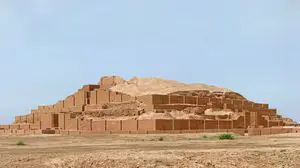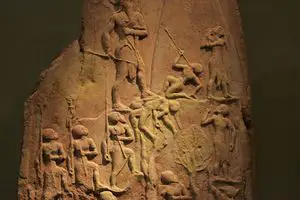How Did the Elamites Become a Powerful Bronze Age People
In the history of the Bronze Age Near East, the Babylonians, Assyrians, Hittites, and Egyptians get most of the attention, because they comprised what is today considered the “Great Powers Club” of the region. Those kingdoms traded, fought, and made alliances with each other in their quests for power and influence in the region. But just to the east of Mesopotamia, in what is today western Iran, was the equally powerful kingdom of Elam. Although the Elamites are not considered one of the traditional members of the Great Powers Club, their influence in the Bronze Age Near East was just as profound.
For nearly 2,000 years, the Elamites carved out a kingdom in what became known as Elam, undergoing a similar ebb and flow of powerful dynasties and collapses as their Mesopotamian neighbors. Around the year 1500 BC, as the other major kingdoms of the Near East were forming the Great Powers Club, the Elamite Middle Kingdom formed, comprising three dynasties that successfully held power until about 1100 BC. The Elamites’ rise to dominance in this period was partly built upon successes of early periods but was also due to new ideas in trade and government that came from able, vigorous kings. The Elamites were also able to temporarily take advantage of the Bronze Age collapse that adversely affected most of the members of the Great Powers Club.
The Elamites’ Origins
The Elamites’ homeland is a region known as Khuzestan in southwestern Iran. The geographical and political center of most of Elamite history was the city of Susa and its surrounding environs. However, the region of Fars in the Zagros Mountains and Anshan were also considered part of historical Elam. [1] The extent to how much of this land was controlled by a particular Elamite dynasty would fluctuate, with Susa almost always being the point from where the dynasty would begin and expand.
Archaeologists trace the origins of Elamite culture to Susa in the early third millennium BC. Although this early Elamite, or “Proto-Elamite,” culture as it is often known as was more Iranian than Mesopotamian in nature, it did borrow some elements from Mesopotamia, most notably writing. Writing in Elam developed around the same time as it did in Mesopotamia (c. 3100 BC) and the Elamites employed a cuneiform script in their writing, which suggests that the Elamites were inspired or influenced by their western neighbors in that regard. [2] The corpus of Elamite texts from this period is very minimal and primarily consists of seals with single words. However, several interesting accounting tables have been recovered. A number of small, seven-inch clay tablets dated from 3100 to 2900 BC have been discovered in Susa that demonstrates the Elamites grasped and utilized advanced mathematical theories and accounting methods and a relatively early point in their history. [3]
As much as scholars know about early Elamite history, details about the Elamites’ language and ethnicity remain somewhat enigmatic. Although the language has been deciphered and the texts can be read, the Elamite language appears to be unrelated to other languages. In the earlier periods of Elamite history, the Akkadian language was often used in royal and monumental inscriptions. Still, by the Middle Elamite Period, the Elamite language was used with the cuneiform script. The ethnic origins of the Elamites also remain unknown, although by the historical period they were comprised of peoples from different cultural backgrounds within the region. [4]
The Middle Elamite Kingdom
The Elamites began to play a more significant role in Near Eastern geopolitics during the Old Elamite Period (c. 2700-1700 BC). The Elamites were a major factor in the collapse of the Ur III Dynasty (c. 2112-2004 BC), which allowed them to occupy cities in southern Mesopotamia. Elamite expansion in Mesopotamia continued for nearly 300 years until it was stopped by Hammurabi of Babylon (ruled c. 1792-1750), who made sure that his kingdom was the most powerful in the region. [5]
After about 200 years, the Elamites once again asserted themselves in the region. By the year 1500, the major kingdoms of the Near East were either in or about to be in the periods of their greatest imperial expansion. As these kingdoms formed the Great Powers Club, dividing up the region among themselves, the Elamites were reconsolidating their hold on Elam. Striking out from Susa, the Elamites united the region around their capital with the highlands to the south near Anshan, establishing the Middle Elamite Kingdom. Proving to be the most powerful and influential Elamite kingdom in history, the Middle Elamite Kingdom was comprised of three different dynasties. The kings of the Middle Elamite Kingdom developed a sophisticated and what was at the time modern administrative state. The Elamites exchanged embassies with the Babylonians and later the Assyrians and had indirect communication with people farther to the west through trade. [6]
Perhaps the greatest Elamite king from this period was Untash-Napirsha (ruled c. 1275-1240 BC), who built a new city, Al-Untash-Napirisha (Untash-Napirishaville or Untash-Napirishaberg), about twenty-five miles southeast of Susa. [7] Al-Untash-Napirisha was dedicated to Inshushinak, the patron god of Susa, with its centerpiece being a large ziggurat. Ziggurats were Mesopotamian style temple complexes. Although Untash-Napirisha’s ziggurat followed the basic architectural features of earlier Mesopotamian ziggurats, it is unique in many ways. For instance, many of the thousands of bricks used in its construction have Elamite cuneiform inscriptions. [8] Al-Untash-Napirisha has also yielded several treasures to modern archaeologists, including a life size bronze states of Untash-Napirisha’s queen, Napirasu. [9] But as great as Al-Untash-Napirisha was, and as much as it was a testament to the growing power of the Elamites during the Late Bronze Age, it was, for the most part, abandoned after Untash-Napirisha’s reign. The later rulers of the Middle Elamite Kingdom found more opportunities for expansion in Mesopotamia.
Taking Advantage of Collapse
By 1200 BC the situation in the Near East had taken a drastic turn. Migrations and invasions had adversely affected nearly all of the Great Powers: the Egyptians barely survived attacks by the Sea Peoples and Libyans, the Sea Peoples and Phrygians destroyed the Hittite Empire, and the Sea Peoples ravaged large parts of the Levant. Babylonia also suffered attacks at the hands of Arameans and Chaldeans. [10] The Elamites, though, were relatively unaffected by the migrations, which allowed the Shutrikid Dynasty – the most powerful Elamite Dynasty – to come to power.
Besides rebuilding Susa in their image, the Shutrikid kings embarked on an aggressive military campaign, taking advantage of the general confusion in Mesopotamia. In 1155, King Shutruk-Nahhunte (ruled c. 1185-1155) led an army out of Elam into Babylonia, ending the Kassite Babylonian Dynasty. The Elamite king and his successors then looted Babylon, and took back many of the city’s most famous works of art, such as the “Victory Stela of Naram Sin” and the Law Code of Hammurabi, with them to Elam. The situation was recorded in an Akkadian language text known as the “Prophesy of Marduk.”
“A ruler will arise; he will rule for thirteen years. There will be an attack of Elam against Akkad, and the booty of Akkad will be carried off. The temples of the great gods will be destroyed; the defeat of Akkad will be decreed (by the gods). There will be confusion, disturbance, and unhappy events in the land, and the reign will diminish (in power); another man, whose name is not mentioned (as a successor) will arise, and will seize the throne as king and will put to death his officials. He will fill the corpses of half the army the lowlands of Tupliash, open and level ground, and the people of the land will experience a severe famine.” [11]
Shutruk-Nahhunte’s successor and son, Kudur-Nahhunte (reigned c. 1155-1150 BC), was left in control of Babylon and is believed to be the one who took the sacred Marduk statue to Susa. His successor, Shilak-Inshushinak (ruled c. 1150-1120 BC), is found to have retained Elamite control over the Tigris River region. Still, his reign was the apex of Elamite imperial rule – Nebuchadnezzar I (reigned ca. 1125-1104 BC), the King of Isin, ended Elamite expansion into Mesopotamia. [12] The Elamite Middle Kingdom collapsed soon after, and Elam descended into another dark age.
Conclusion
The Elamites played an important role in the history of ancient Persia and the Near East. From humble beginnings, the Elamites grew to be a powerful force in the region by the Late Bronze Age. They were able to become powerful by uniting their land under the rulership of several able kings who initiated sophisticated building, trade, and diplomatic policies. The Elamite kings were also able to take advantage of the general collapse in the Near East at the end of the Bronze Age. However, their time as a dominant Bronze Age people ultimately proved to be ephemeral.
References
- Jump up ↑ Kuhrt, Amélie. The Ancient Near East: c. 3000-330 BC. (London: Routledge, 2010), p. 365
- Jump up ↑ Pittman, Holly. “Proto-Elamite Art.” In The Royal City of Susa: Ancient Near Eastern Treasures in the Louvre. Edited by Prudence O. Harper, Joan Aruz, and Françoise Tallon. (New York: Metropolitan Museum of Art, 1993), p. 68
- Jump up ↑ Stolper, Matthew W. “Proto-Elamite Seals and Sealings.” In The Royal City of Susa: Ancient Near Eastern Treasures in the Louvre. Edited by Prudence O. Harper, Joan Aruz, and Françoise Tallon. (New York: Metropolitan Museum of Art, 1993), p. 77
- Jump up ↑ Mieroop, Marc van de. A History of the Ancient Near East: ca. 3000-323 BC. Second Edition. (London: Blackwell, 2007), p. 185
- Jump up ↑ Mieroop, p. 111
- Jump up ↑ Kuhrt, p. 369
- Jump up ↑ Carter, Elizabeth. “The Middle Elamite Period: Circa 1500-1000 BC.” In The Royal City of Susa: Ancient Near Eastern Treasures in the Louvre. Edited by Prudence O. Harper, Joan Aruz, and Françoise Tallon. (New York: Metropolitan Museum of Art, 1993), p. 121
- Jump up ↑ Carter, p. 121
- Jump up ↑ Frankfort, Henri. The Art and Architecture of the Ancient Orient. Fourth Edition. (New Haven, Connecticut: Yale University Press, 1996), p. 335
- Jump up ↑ Haywood, John. The Penguin Historical Atlas of Ancient Civilizations. (London: Penguin, 2005), pgs., 40-41
- Jump up ↑ Pritchard, James B, ed. Ancient Near Eastern Texts Relating to the Old Testament. Third Edition. (Princeton, New Jersey: Princeton University Press, 1992), p. 606
- Jump up ↑ Kuhrt pgs. 372-3



